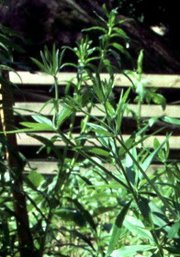Madder
|
|
| Madder | ||||||||||||
|---|---|---|---|---|---|---|---|---|---|---|---|---|
| Missing image Rubia.tinctorum02.jpg Common Madder (Rubia tinctorum) | ||||||||||||
| Scientific classification | ||||||||||||
| ||||||||||||
| Species | ||||||||||||
|
See text. |
Madder is the common name of the plant genus Rubia L., the type genus of the madder family Rubiaceae.
The genus contains about 60 species of perennial scrambling or climbing herbs and sub-shrubs native to the Old World, Africa, temperate Asia and America.
The best known species are Common Madder (Rubia tinctorum), Wild Madder (Rubia peregrina), and Indian Madder (Rubia cordifolia).
The Common Madder can grow to 1.5 m in height. The evergreen leaves are 5-10 cm long and 2-3 cm broad, produced in whorls of 4-7 starlike around the central stem. It climbs with tiny hooks at the leaves and stems. The flowers are small (3-5 mm across), with five pale yellow petals, in dense racemes, and appear from June to August, followed by small (4-6 mm diameter) red to black berries. The roots are between 20-30 cm long, up to 12 mm thick and the source of a red dye. It prefers loamy soils with a constant level of moisture.
Madders are used as food plants for the larvae of some Lepidoptera species including Hummingbird hawk moth.
- Species
- Rubia akane
- Rubia alaica Pachom.
- Rubia angustifolia L.
- Rubia angustifolia ssp. angustifolia
- Rubia angustifolia ssp. caespitosa
- Rubia chinensis Regel & Maack
- Rubia chitralensis Ehrend.
- Rubia cordata Thunb
- Rubia cordifolia L. : Indian Madder
- Rubia cretacea Pojark.
- Rubia deserticola Pojark.
- Rubia dolichophylla Schrenk
 A madder plant in the open air museum Asparn, Austria
A madder plant in the open air museum Asparn, Austria - Rubia florida Boiss.
- Rubia fruticosa
- Rubia jesoensis (Miq.) Miyabe & Miyake
- Rubia komarovii Pojark.
- Rubia krascheninnikovii Pojark.
- Rubia laevissima Tscherneva
- Rubia laxiflora Gontsch.
- Rubia pavlovii Bajtenov & Myrz.
- Rubia peregrina L. : Wild Madder
- Rubia rechingeri Ehrend.
- Rubia regelii Pojark.
- Rubia rezniczenkoana Litv.
- Rubia rigidifolia Pojark.
- Rubia schugnanica B.Fedtsch. ex Pojark.
- Rubia sikkimensis Kurz
- Rubia syrticola Miq.
- Rubia tatarica (Trevir.) F.Schmidt
- Rubia tibetica Hook.f.
- Rubia tinctorum L. : Common Madder
- Rubia transcaucasica Grossh.
- Rubia yunnanensis (Franch. ex Diels) Diels
Uses
It has been used since ancient times as a vegetable red dye for leather, wool, cotton and silk. For dye production, the roots are harvested in the first year. The outer brown layer gives the common variety of the dye, the lower yellow layer the refined variety. The dye is fixed to the cloth with help of a mordant, most commonly alum. Madder can be fermented for dyeing as well (Fleurs de garance). In France, the remains were used to produce a spirit as well.
The roots contain the acid ruberthyrin. By drying, fermenting or a treatment with acids, this is changed to sugar, alizarin and purpurine. Purpurine is not coloured, but is red when dissolved in alcalic solutions. Mixed with clay and treated with alum and ammonic, it gives a brilliant red colourant (madder lake).
Illustration_Rubia_tinctorum0.jpg
The pulverised roots can be dissolved in sulfuric acid, which leaves a dye called garance (the French name for madder) after drying. Another method of increasing the yield consisted of dissolving the roots in sulfuric acid after they had been used for dyeing. This produces a dye called garanceux. By treating the pulverized roots with alcohol, colorin was produced. It contained 40-50 times the amount of alizarine of the roots.
The chemical name for the pigment is alizarin, of the Anthachrinone-group. In 1869, the German chemists Graebe and Liebermann synthesised artificial alizarin, which was produced industrially from 1871 onwards, which effectively put an end to the cultivation of madder. In the 20th century, madder was only grown in some areas of France.
History
Dioscorides and Pliny the Elder (De Re Natura) mention the plant (Rubia passiva). In Viking age levels of York, remains of both woad and madder have been excavated. The oldest textiles dyed with madder come from the grave of the Merovingian queen Arnegundis in St. Denis near Paris (between 565 und 570 AD). In the "Capitulare de villis" of Charlemagne, madder is mentioned as "warentiam". The herbal of Hildegard of Bingen mentions the plant as well. The red coats of the British Redcoats were dyed with madder.
According to Culpeper's herbal, the plant is ruled by Mars and has an opening quality, and will bind and strengthen afterwards. It was used in the treatment of jaundice, obstruction of the spleen, melancholy, palsy, haemorrhoids, sciatica, and of bruises. The root should be boiled in wine, and sugar or honey added. The seed of madder, drunk with vinegar and honey is used for the swelling of the spleen. Leaves and stems are used when the monthly bleeding is late. Leaves and roots are squashed and put on freckles and other discolorations of the skin.
References
- R. Chenciner, Madder red: a history of luxury and trade (Richmond 2000).de:Färberkrapp
